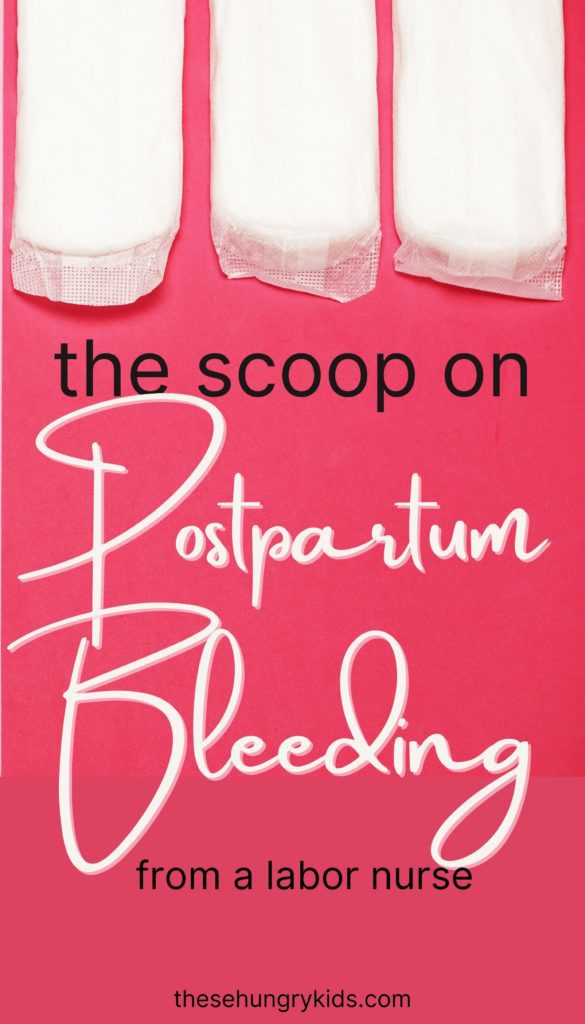Bringing your baby into the world is an overwhelming and exciting event! But many new moms are confused by all of the new things their body is doing.
Vaginal bleeding after birth surprises many new parents, but it’s totally normal after both a vaginal birth and cesarean delivery. After the birth of your baby comes the delivery of the placenta. When the placenta detaches from the uterine wall, it leaves an open wound. As the uterus shrinks down, it constricts those blood vessels and heals that wound to slow down the bleeding. Additionally, your body will shed the lining of the uterus, which has grown thick during pregnancy. In a way, this is like your first period since getting pregnant.
While I am a labor and delivery nurse, I am not your nurse and cannot give you medical advice. Any questions or concerns you have about your health should be directed to your healthcare provider. Please read my disclaimers for more information.
Related: 15 Things That Surprised Me About Life After Baby: Best Advice For New Parents

Postpartum bleeding stopped then started again…is this normal?
While vaginal bleeding is normal after delivery, it should taper off and change in color and consistency in the weeks following birth. You may notice that the discharge increases slightly when you are up and active or while you are breastfeeding.
It can also be normal for the bleeding to get lighter and then slightly heavier again. It should not be a continuous heavy flow, but small gushes are normal as the uterus contracts.
It is not typically normal for postpartum bleeding to stop entirely and then start again, this could be a sign of a problem. It’s always a good idea to call your health care provider if you think you are bleeding too much. It can be normal for bleeding to increase slightly with activity, but you should not experience a sudden gush of bright red blood, or anything beyond some intermittent spotting or streaks of blood in your vaginal discharge.

How much postpartum bleeding is normal?
Vaginal bleeding is normal after a vaginal delivery or a cesarean section. Your doctor or midwife and nurses will watch you during your hospital stay to make sure the bleeding is not too heavy.
Generally speaking, soaking through more than one maternity pad per hour, or passing any large clots, could be a cause for concern. This would be heavy bleeding, and you should notify your provider.
Related: Pain When Breastfeeding? Try These 10 Things
After your birth, your medical team will keep a close watch on your bleeding. Your nurse will check your blood pressure frequently and will do a fundal massage. Fundal massages are anything but fun – they are when your nurse or provider massages your belly over the uterus to express extra blood and ensure the uterus is shrinking down.
This uterine massage can be quite uncomfortable, but they are an effective way to prevent postpartum hemorrhage. Your uterus won’t completely shrink down to normal size until about 6 weeks postpartum.
The typical blood loss with a vaginal birth is less than 500ml and less than 1000ml with a cesarean section. Any blood loss greater than those parameters would indicated a postpartum hemorrhage. Hemorrhage is one of the most common postpartum complications.

Related: How Dads Can Help Moms With Postpartum Depression
Types of postpartum discharge
Vaginal discharge is to be expected after delivery. This discharge is called lochia, and it will change in color and consistency in the days to weeks after delivery. Lochia is made of blood, discharge, amniotic fluid, and tissue. It’s your body’s way of cleaning out the uterus after birth, and it’s totally normal.
Lochia stages
The first few days, you will have lochia rubra, meaning the discharge is dark red or a brownish color. It’s mostly made up of excess blood and is normal as the uterus heals from birth. Small blood clots, no larger than a golf ball or clementine, are normal. Passing large clots or soaking through a maternity pad could be an indication of postpartum hemorrhage.
Bright red bleeding is only normal in the first few days after delivery. Bleeding should not happen weeks after delivery, and the bleeding should be slowing down, not increasing.
After about 4 days after birth, the discharge will lighten in color to become lochia serosa. This type of discharge is usually a light pink and tends to be more watery. You may notice a lighter flow.
The following weeks, you may notice a more thin, white discharge called lochia alba. There may occasionally be a little blood in the discharge, but it is mostly a thin, white discharge. It mainly consists of white blood cells leaving the body after healing the uterus. This may last for up to 6-8 weeks postpartum.
You should use pads, not tampons or menstrual cups, while you are having postpartum discharge. Sexual intercourse is not advised for the first 6-8 weeks after delivery because of the risk of infection.
You may experience some cramping in the first week or so after birth, especially if you are breastfeeding. This is because the uterine contractions don’t stop with labor!
Your uterus is working hard to shrink in size. This helps constrict the blood vessels inside of the uterus and slow down blood loss.

Related: The Best Postpartum Belly Wraps and Girdles (2022)
When to seek medical attention
You should call your medical provider with any questions or concerns about your health. However, if you experience any of the following, call your healthcare provider right away!
- Your bleeding increases. Bleeding should slow down after birth. If you start to have an increase in bright red bleeding, or pass clots larger than a golf ball, this could be a sign of postpartum hemorrhage. Bleeding at 4 weeks postpartum is not normal and neither is bright red bleeding at 6 weeks postpartum. You should call your provider if bleeding has continued past that time.
- If you develop a fever. If you are feeling unwell, or have a fever over 100.4 degrees, it’s time to call your provider. A high temperature could be a sign of infection and needs medical help.
- Foul smelling lochia. Lochia may have a slight smell, similar to the smell of menstrual blood. But if your lochia smells offensive, it may be worth getting checked out.
- Pelvic pain. Cramping is normal as the uterus contracts after birth. But severe pain in the pelvis can be a sign of infection.
- Continuing to pass large clots. Passing large clots is not normal after the first few days postpartum. This can be a sign of retained placenta or excessive bleeding and requires medical attention.
Related: The Best Postpartum Nightgowns And Loungewear (For Comfort & Breastfeeding)
When does the normal menstrual cycle return?
The return of menses, or getting your period back, depends on a few things. For most women that do not breastfeed, the return of your menstrual cycle will happen within the first 12 weeks after delivery. Many moms claim that the first postpartum period after birth is a very heavy period.
If you are breastfeeding, you may not have a return of menstrual bleeding until you are done breastfeeding. This is called lactational amenorrhea, and is totally normal. Be careful – you can still get pregnant when breastfeeding!
Congratulations on your new bundle of joy! Have any other questions about postpartum bleeding? Leave them for me in the comments below.


